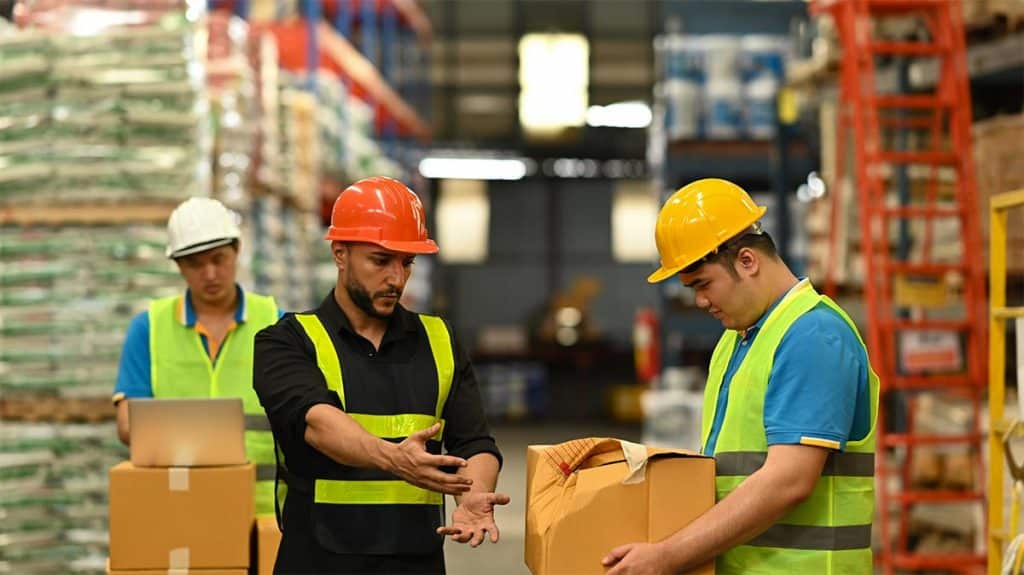Divisions
Not Finding What You're Looking For?
Head over to our contact page and tell us what you’re looking for and we’ll handle the rest!
Head over to our contact page and tell us what you’re looking for and we’ll handle the rest!

Material handling is a critical aspect of warehouse and industrial operations. Efficient and effective material handling not only ensures the smooth flow of goods throughout the system, but also plays a crucial role in preventing damage to both products and personnel. Let’s explore various methodologies, safeguards, and tools that contribute to effective damage prevention in material handling.
Understanding the risks associated with material handling is crucial for any organization, not only from a safety perspective but also in terms of financial implications. Product damage results in significant financial losses, affecting a company’s bottom line and reputation. Injuries to personnel lead to increased workers’ compensation claims and potential legal ramifications. Equipment damage, whether to forklifts or other machinery, incurs costly repair or replacement costs and operational downtime. It’s simply good business sense to prioritize preventive measures, such as making an upfront investment in safety and proper handling, in order to prevent the potential long-term costs associated with accidents, injuries, and damaged goods. By comprehensively addressing these risks, organizations not only protect their financial interests but also foster a safer and more productive work environment.
Indoff understands these risks and has the solutions you need to prioritize prevention.
Preventing problems in the warehouse requires a multi-faceted approach.
Efficient material handling isn’t just about moving goods from point A to point B; it’s a crucial strategy to prevent damages in the warehouse. The choice of appropriate machinery tailored to specific needs ensures a streamlined workflow, reducing the risk of accidents and damage. For example, in a bustling distribution center dealing with various product sizes, having a fleet of forklifts with different capacities ensures delicate items are handled with care. In a manufacturing facility, where the risk of damage to raw materials or finished goods is high, investing in automated conveyor systems minimizes human touchpoints, reducing the chances of mishandling. Having sufficient, optimized storage solutions doesn’t just maximize warehouse storage efficiency, it also reduces the risk of damages that occur when inventory is crammed, jammed, or otherwise mishandled.
Prioritizing employee safety is not just a legal requirement; it’s a cornerstone in preventing damages. Well-trained employees who understand the intricacies of material handling equipment contribute significantly to damage prevention. In a retail warehouse, where products move swiftly, trained, healthy employees ensure delicate items are handled with precision, reducing the risk of breakage. Ergonomics plays a vital role in preventing damages caused by mishandling. Comfortable workstations in a manufacturing plant contribute to employee well-being, reducing the chances of errors that could result in damaged goods.
Beyond basics, additional safety measures contribute to holistic damage prevention in the warehouse. Clearly marked pathways and safety signs guide the movement of goods, preventing collisions and damages. In a distribution center, where efficiency is key, floor markings direct the flow of traffic, reducing the risk of accidents. Physical barriers, such as protective guards on conveyor systems, prevent accidental contact with moving parts, ensuring goods remain intact. Regular safety audits in large-scale warehouses identify potential risks and areas for improvement, contributing to overall damage prevention. Indoff can help you get access to the safety products every warehouse needs.

With the risks and basics in hand, you’re prepared to start thinking about methods and tools for making damage prevention a core goal of your material handling system.
Well-trained personnel are fundamental to effective material handling. Training programs should cover proper lifting techniques, equipment operation, and awareness of potential hazards.
Design workstations and workflows with ergonomic principles in mind. This helps reduce the physical strain on workers and minimizes the risk of injuries.
Thoughtful layout planning ensures that storage areas, pathways, and workstations are organized for optimal efficiency and safety. This prevents unnecessary congestion and collisions.
Regular maintenance of material handling equipment is crucial. Well-maintained machinery is less likely to malfunction, reducing the risk of accidents and damage.
Automation in material handling can significantly reduce the risk of both product and equipment damage. Automated systems are precise and less prone to human errors.
Safety doesn’t just happen, you need to build it into your warehouse space with tools like the following:
Installing barriers and guardrails along walkways and around machinery helps create designated pathways for pedestrians and protects equipment from accidental collisions.
Advanced technologies, such as anti-collision systems for forklifts and other equipment, can automatically detect obstacles and prevent collisions.
Netting and strapping systems are effective in securing products during storage and transportation, preventing shifting and damage.
Choosing appropriate packaging materials and techniques helps safeguard products from damage during transit and storage.
Clear and visible signage indicating safety protocols, traffic directions, and potential hazards contributes to a safer working environment.
Investing in quality safety products such as the following significantly enhances damage prevention efforts:
These protectors absorb impact forces, preventing damage to pallet racking systems caused by forklift collisions.
Placed strategically, safety bollards act as physical barriers, preventing equipment from colliding with vulnerable areas.
Convex safety mirrors improve visibility in blind spots, reducing the risk of collisions.
Slip-resistant flooring materials contribute to a safer working environment, especially in areas prone to spills or moisture.
Conclusion
Effective damage prevention in material handling involves a combination of methodologies, safeguards, and investment in the right tools and infrastructure. By prioritizing safety, organizations not only protect their products and equipment but, more importantly, ensure the well-being of their workforce. A comprehensive approach to damage prevention is an investment in both operational efficiency and the overall health and safety of the workplace.
The team at Indoff is here to help every step of the way. From mapping out your warehouse space and the most efficient storage plan to sourcing the equipment you need to move inventory safely and quickly and everything in between, we’ve got you covered. Our expertise and industry resources make us an indispensable partner in your efforts to build a better, safer, more efficient warehouse.
Courtney joined Indoff in 2010. She brings years of experience in project management and tech solutions and is responsible for supporting our Partners’ sales efforts.
Phone: (314) 997-1122 ext. 1291
courtney.brazell@indoff.com
Josh joined Indoff in 2013 as part of the acquisition of Allied Appliance and was paramount to Indoff’s acquisition of Absocold, a manufacturer of refrigerators and microwaves, in 2017. In 2025, Josh was promoted to President of Indoff, where he collaborates closely with Indoff’s Partners and Marketing department to develop and implement strategies that enhance the Indoff brand. Josh’s leadership and industry knowledge are instrumental in ensuring Indoff remains a leading provider of business solutions nationwide.
Phone: (314) 997-1122 ext. 1107
josh.long@indoff.com
Jim joined Indoff in 1988 after spending 5 years at Ernst & Young, where he specialized in audit and accounting for privately-held businesses. Jim is responsible for the day-to-day management of Indoff.
Phone: (314) 997-1122 ext. 1203
jim.malkus@indoff.com
John’s background includes the start up and acquisition of several successful business ventures, and he provides strategic planning and overall corporate governance.
Phone: (314) 997-1122 ext. 1201
john.ross@indoff.com